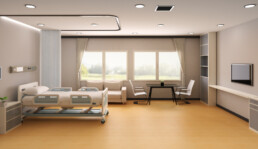Building Better Day Surgery Centres: Design Tips for Maximum Impact
The Rise of Day Surgery Centres
“Healthcare is evolving, and so are the spaces where care is delivered. Ambulatory Surgery Centres or day surgery centres are a testament to how thoughtful design can enhance efficiency and patient experience,”
Kshititi Nagarkar, Principal Architect at Shree Designs.
With more than 80% of surgeries now performed in outpatient settings, the demand for Ambulatory Surgery Centres (ASCs) continues to soar. Their cost-efficiency, convenience, and faster recovery times make them a preferred choice for both patients and providers.
ASCs are not only affordable but also designed for speed and comfort.
Smaller, less crowded environments ensure personalized care, while streamlined operations reduce costs and improve patient satisfaction. Between 2012 and 2022, the number of ASCs grew by 32%, with revenue increasing by 42%, highlighting their pivotal role in modern healthcare.
Well-planned design goes beyond aesthetics in ASCs—it optimizes workflows, accelerates turnaround times, and creates an environment that prioritizes patient and staff well-being.
What Makes Ambulatory Surgery Unique?
Ambulatory Surgery Centres (ASCs) operate differently from traditional hospitals, focusing on efficiency and specialization. Unlike hospitals, where patients may stay for extended periods, ASCs handle a higher patient volume in significantly shorter timeframes. This fast-paced environment requires meticulous planning to manage patient flow, ensuring seamless transitions from check-in to discharge.
The specialized nature of procedures performed in ASCs also calls for tailored layouts that accommodate specific surgical workflows while maximizing space efficiency. For instance, operating rooms must be designed for quick turnovers, and recovery areas need to support a high throughput without compromising patient comfort.
Every design decision in an ASC—from the placement of pre-op and post-op areas to streamlined pathways for staff and patients—is driven by the need to maintain speed, precision, and a positive patient experience.
Design Principles for Optimising Day Surgery Centres
To ensure efficiency, patient satisfaction, and profitability in ambulatory surgery centres (ASC), the following healthcare architecture and hospital design principles are essential:
1. Streamlined Patient Flow
The foundation of any efficient ASC is a layout that supports smooth patient transitions, without bottle necks. Separate entrances for incoming and outgoing patients can prevent cross-traffic, reducing delays and confusion.
Dedicated hallways for staff movement ensure operational flow remains uninterrupted, even during peak hours. A linear arrangement—from reception to pre-op, operating rooms, recovery, and discharge—optimizes patient flow and minimizes unnecessary backtracking.
Discover how effective wayfinding transforms hospital navigation – read our blog on Navigational Design in Hospitals.
2. Centralized and Shared Resources
Centralized resource stations, such as shared supply rooms near operating theatres, eliminate time-consuming trips to retrieve materials. Similarly, nurse stations strategically positioned to oversee multiple rooms improve workflow efficiency and patient monitoring. These smart placements not only reduce walking distances but also enable faster responses in critical moments, ultimately enhancing overall operations.
Explore how efficient design impacts operations – learn more about Tracking Metrics to Evaluate Design Efficacy.
3. Flexibility and Scalability
Ambulatory Surgery Centres must be prepared to evolve with advancements in medical technology and fluctuating patient needs. Modular operating rooms that accommodate different surgical specialties allow facilities to remain versatile. Recovery areas designed with convertible partitions provide flexibility to handle individual or group care scenarios, adjusting to patient volume and staffing requirements seamlessly.
Find out how adaptable designs future-proof healthcare spaces – read our blog on Building for Tomorrow: The Imperative of Adaptable Healthcare Design.
4. Patient-Centric Comfort
While ASCs emphasize speed and efficiency, patient comfort should not be overlooked. Thoughtful design elements such as recovery rooms with reclining chairs foster faster healing. Family-friendly waiting areas equipped with refreshments, comfortable seating, and charging stations enhance the overall patient and family experience, reducing stress during what can be an anxious time.
Discover how neuroaesthetics elevate patient experiences – dive into our blog on Neuroaesthetics in Architecture.
5. Technology Integration
Technology plays a crucial role in optimising ASC operations. Real-time patient tracking systems provide visibility into each patient’s journey, ensuring smooth handoffs between pre-op, surgery, and recovery. Integrated surgical equipment not only reduces setup time but also ensures faster pre-op and post-op processes. This technological edge enables ASCs to maintain high efficiency while delivering excellent care.
Learn how cutting-edge solutions enhance efficiency – explore Healthcare Design for Greenfield Projects
Designing the Future of Day Surgery
Efficiency and comfort go hand-in-hand. Ambulatory Surgery Centres are the future of healthcare, combining speed, precision, and patient-focused care. The right layout can minimise delays, maximise resource use, and foster an environment that prioritizes healing and collaboration.
As demand for outpatient surgeries continues to grow, now is the time to rethink your facility’s design.
Ready to Redesign Your Day Surgery Centre?
Let Shree Designs help you craft a space that works as hard as you do.
Explore our portfolio of innovative healthcare design projects.
Schedule a consultation with our experts for custom solutions.
Together, let’s design spaces where efficiency meets care.
Related Posts
Designing Healthcare Facilities,Infographic,Project Management
Designing Healthcare Spaces That Truly Heal
From concept to completion, every medical space we design prioritizes patient flow, staff…
Designing Healthcare Facilities
The Business of Wellness
In the $1.8 trillion wellness industry, first impressions matter. Patients don’t just choose a…
Designing Healthcare Facilities
Efficient Hospital and Clinic Design
India’s emerging cities are growing rapidly, creating an urgent demand for accessible and efficient…
Designing Healthcare Facilities
Creating Calming and Confidential Spaces for Fertility Clinics
As the demand for fertility treatments grows, the architecture of these clinics plays a vital role…
Designing Healthcare Facilities
Designing the Perfect Hospital Pharmacy
Hospital pharmacies are the backbone of seamless patient care. From efficient workflows to secure…
Designing Healthcare Facilities
Preventive Care Facility Design Strategies
With preventive care emerging as the future of healthcare, this post outlines key architectural…
Designing Healthcare Facilities
Thermal Comfort Decoded
Thermal comfort plays a critical role in patient recovery, staff productivity, and overall…
Designing Healthcare Facilities
Building for Tomorrow: The Imperative of Adaptable Healthcare Design
Healthcare facilities need to be as dynamic as the industry itself. Traditional, rigid designs can…
Designing Healthcare Facilities
Designing Single Speciality Healthcare Centres
As single-speciality centres grow, their design needs become more specific, calling for tailored…
Designing Healthcare Facilities
Innovative Design Solutions for Senior Care Facilities
Designing senior-friendly spaces in healthcare facilities is crucial for catering to the evolving…
Designing Healthcare Facilities
Designing a Dental Clinic for Success
Providing quality dental care is not just about the technical elements of the treatment. It's also…
Designing Healthcare Facilities
3 Essential Design Features for Intensive Care Units
ICUs are not just limited to single units housing all critical patients. If the facility has…
Designing Healthcare Facilities
3 Lessons Learned While Building a Cardiac Cath Lab
Cardiac care design is moving at the sound of a new beat! The number of Cath labs in India has…
Designing Healthcare Facilities
5 Essential Elements of Healthcare Design
Design makes a significant impact on the delivery of care for both healthcare providers and…
Designing Healthcare Facilities
5 Best Ways to Create Healing Spaces for Kids
Designing spaces in healthcare facilities tailor-made for children is a lesson in balance! A…
Designing Healthcare Facilities
Top 5 Trends in Healthcare Design
Design can make all the difference when it comes to improving patient care. From a patient’s point…
Designing Healthcare Facilities
The Architectural Design of Hospital Facilities
Shree Designs designed and executed many efficient and safe healthcare setups in the middle of the…
Designing Healthcare Facilities
Dauntless Designers
Healthcare Radius in its 7th Anniversary Special issue in October 2019, featured a "power list of…
Designing Healthcare Facilities
The changing face of healthcare design
After completing a decade in designing healthcare projects, Kshititi Nagarkar, principal architect,…
Designing Healthcare Facilities
Thumb Rules for Planning and Designing of Hospitals
Traditional rules of thumb in healthcare planning have changed. Once-accepted rules can now be the…



















